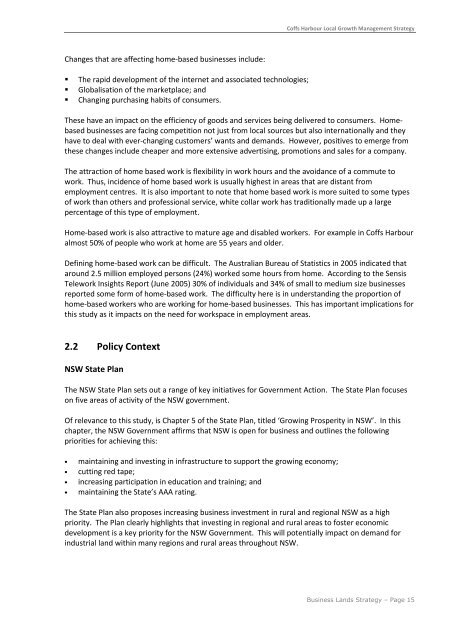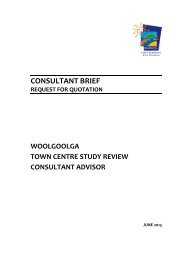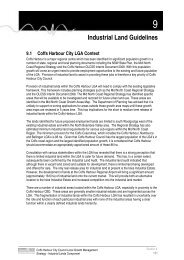Business Lands Strategic Plan - Coffs Harbour City Council - NSW ...
Business Lands Strategic Plan - Coffs Harbour City Council - NSW ...
Business Lands Strategic Plan - Coffs Harbour City Council - NSW ...
You also want an ePaper? Increase the reach of your titles
YUMPU automatically turns print PDFs into web optimized ePapers that Google loves.
<strong>Coffs</strong> <strong>Harbour</strong> Local Growth Management Strategy<br />
Changes that are affecting home-based businesses include:<br />
<br />
<br />
<br />
The rapid development of the internet and associated technologies;<br />
Globalisation of the marketplace; and<br />
Changing purchasing habits of consumers.<br />
These have an impact on the efficiency of goods and services being delivered to consumers. Homebased<br />
businesses are facing competition not just from local sources but also internationally and they<br />
have to deal with ever-changing customers’ wants and demands. However, positives to emerge from<br />
these changes include cheaper and more extensive advertising, promotions and sales for a company.<br />
The attraction of home based work is flexibility in work hours and the avoidance of a commute to<br />
work. Thus, incidence of home based work is usually highest in areas that are distant from<br />
employment centres. It is also important to note that home based work is more suited to some types<br />
of work than others and professional service, white collar work has traditionally made up a large<br />
percentage of this type of employment.<br />
Home-based work is also attractive to mature age and disabled workers. For example in <strong>Coffs</strong> <strong>Harbour</strong><br />
almost 50% of people who work at home are 55 years and older.<br />
Defining home-based work can be difficult. The Australian Bureau of Statistics in 2005 indicated that<br />
around 2.5 million employed persons (24%) worked some hours from home. According to the Sensis<br />
Telework Insights Report (June 2005) 30% of individuals and 34% of small to medium size businesses<br />
reported some form of home-based work. The difficulty here is in understanding the proportion of<br />
home-based workers who are working for home-based businesses. This has important implications for<br />
this study as it impacts on the need for workspace in employment areas.<br />
2.2 Policy Context<br />
<strong>NSW</strong> State <strong>Plan</strong><br />
The <strong>NSW</strong> State <strong>Plan</strong> sets out a range of key initiatives for Government Action. The State <strong>Plan</strong> focuses<br />
on five areas of activity of the <strong>NSW</strong> government.<br />
Of relevance to this study, is Chapter 5 of the State <strong>Plan</strong>, titled ‘Growing Prosperity in <strong>NSW</strong>’. In this<br />
chapter, the <strong>NSW</strong> Government affirms that <strong>NSW</strong> is open for business and outlines the following<br />
priorities for achieving this:<br />
• maintaining and investing in infrastructure to support the growing economy;<br />
• cutting red tape;<br />
• increasing participation in education and training; and<br />
• maintaining the State’s AAA rating.<br />
The State <strong>Plan</strong> also proposes increasing business investment in rural and regional <strong>NSW</strong> as a high<br />
priority. The <strong>Plan</strong> clearly highlights that investing in regional and rural areas to foster economic<br />
development is a key priority for the <strong>NSW</strong> Government. This will potentially impact on demand for<br />
industrial land within many regions and rural areas throughout <strong>NSW</strong>.<br />
<strong>Business</strong> <strong>Lands</strong> Strategy – Page 15

















